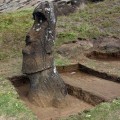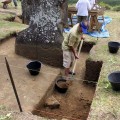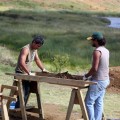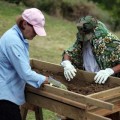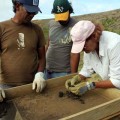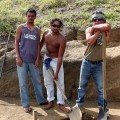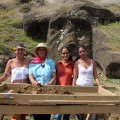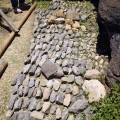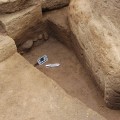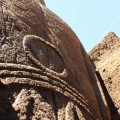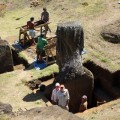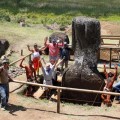Phase 1 Season 2
Easter Island Statue Project Conservation Initiative Preliminary Report October-November 2010
Introduction
This report is a preliminary statement of the tasks undertaken and goals achieved during the second field season of Phase 2 of the Easter Island Statue Project Conservation Initiative. Phase 1 took place in April, 2010 and a full report of that work is on file with the appropriate agencies. This report is a detailed overview but not a final, scientific analysis or synthesis of our findings. That will be produced at the end of the combined work planned for Phase 3 and Phase 4, which entails the similar excavation and study of Moai RR-001-156.
The Conservation Initiative is funded by the Archaeological Institute of America, and its intent is a scientific evaluation of the state of preservation, above and below ground, of the two statues described here (RR-001-156 and RR-001-157). In addition, the Conservation Initiative will monitor and collect scientific data on the discrete environmental contexts of the two statues. These data will be employed to determine the course of stone stabilization treatment to be embarked upon for each statue, and how that treatment may or may not be generalized to other statues.
Project Participants
Jo Anne Van Tilburg, EISP Director and Project Principle Investigator
Cristián Arévalo Pakarati, EISP Co-director
Kim Anh Hoang, EISP Photographer and Collections Manager
Field Crew
Patricio Rodrigo Madariaga Paoa
Darío Icka Paoa
Benjamin Mihaore Pakarati González
Vaiheri Tuki Haoa
Ana “Mosa” Pakarati Icka
Rosa Ika Paoa
Volunteers
Tokerau Pakarati Icka
Hotu Pakarati Icka
Johannes Van Tilburg
Site Monitor
Luisa Fati, CONAF
Log of Phase 1 Activities
Excavation Grid
Jo Anne Van Tilburg and Cristián Arévalo Pakarati re-established the previously laid-out April excavation grid behind Statue RR-001-157 in Quarry 2. Our intent is to follow a three phase plan in which selected squares will be dug to depths of 1m, 2m, and 3m in a stepped pattern. This will provide maximum support for the statue as well as creating a safe space in which to work and adequate room to fully document with drawings and photos the back of the statue.
Screened Deposits, Finds Records, and Archaeological Object Collection, Inventory and Management
All dirt removed from the excavation will be screened through 1/8th screen and objects recovered will be bagged and logged using a unique field identification number which includes the date. All objects recovered from the Quarry 2 surface area or detritus pile at the rear of Quarry 2 will be logged and photographed. Objects are bagged in archival safe paper bags. Carbon is collected with gloved hands and stored in metal tins. All other fragile items are stored in metal tins. All bagged contents will be washed, sorted, weighed, logged, photographed, and stored at the EISP field office (the Mana Gallery). Toki (carving tools) no matter where they are found will be measured and photographed but not removed from the site, as per our previously described agreement with CONAF. Our previously stated plan to remove all artifacts and bagged collections to the island museum for permanent storage is no longer viable as the museum is closed for an indefinite period. All stored material will remain at the Mana Gallery and an itemized log will be provided to the Sonia Haoa, who represents the Consejo de Monumentos Local.
Shovel Scrape
Jo Anne Van Tilburg shovel-scraped all previously excavated squares for UNIT 156 and UNIT 157. A total of 12 buckets of dirt from the surfaces of the squares in both units was removed and screened. A broken toki was loosened and removed from Square 07 at 70 cm deep. It was embedded in the east wall near the NE corner of the square. This object and others like it will be numbered, measured, photographed and logged as individual pieces. A second toki was removed during the shovel scrape of UNIT 156 Square 03 at 70 cm depth. It was better formed than the first and intact.
Photographic Documentation
A full and complete photographic record including digital photography and film will be made in the field to the standards and with the established methodology of EISP, which to date includes an image data base of over 50,000 images. Project photographer Kim Anh Hoang took a first hour and last hour overview of the site every day we were in the field. Objects found but not bagged were photographed in the field with a metric scale on a photographic gray card. Rock art that appeared after the clearing of the detritus pile in Quarry 2 was photographed. Each square was photographed with an identifying placard and north arrow each time a new level was completed. The time of day for this photo was noted in order to provide a record of the visible color and apparent moisture content of the statue stone surface. Bagged collections were photographed in the Mana Gallery. Paper photographic logs are filed in the EISP Archive.
Backdirt and Detritus
A massive amount of overburden in the form of dirt and basalt chips hid large portions of the rear wall area of Quarry 2 (Routledge 1919). This overburden is referred to here as the detritus pile. Some portions of it were screened (see below). The amount of dirt present from 1919 to 2008 was monitored by us prior to excavation through study of photographs collected in our Historic Level Book. For example, over 80 cm of dirt collected as downwash around the torso of statue RR-001-157 from 1919 to 1983.
We removed a large portion of the detritus to our previously established backdirt pile at the front of the excavation and down slope on the opposite side of the tourist path. This was essential in order to provide space in which to work as well as to allow photography and drawing (plan and elevation) of the previously incompletely documented and mapped Quarry 2 (Van Tilburg and Arévalo Pakarati 2009). In addition, Cristián Arévalo Pakarati spent three days clearing the deeply rooted vegetation from the backdirt/detritus pile storage area. This was done in order to keep the pile as clean as possible when it is used to backfill the excavation.
Previously Excavated Historic Levels
The statue was previously excavated by the Mana Expedition to Easter Island, 1914-15. The level reached at that time was apparently just below the “M” form of the “ring and girdle” element on the dorsal side and, therefore, everything to that point is disturbed historic levels. Items of interest in those levels include a quantity of historic material (glass, paper, etc.) as well as carbon. Subsequent excavations were undertaken by the Franco-Belgian Expedition, the Norwegian Archaeological Expedition, and others. All are documented in our Historic Level Book.
Previously Unexcavated Archaeological Levels
From the lowest level of the previously excavated historic levels to the statue base and pavement we were in unexcavated archaeological levels. Items of greatest interest located in those levels include carbon, rat bone, and the “signature stone” described in more detail below.
Detail Documentation
Detailed drawings of the stratigraphic levels are in process, as are field and finished drawings of the petroglyphs and the pavement under and next to the statue. Complete new measurements will also be taken of the 55 attributes usually recorded by EISP on all statues. Due to the discrepancy in the measurements taken by Routledge of, for example, the total height of the statue and the actual height and other dimensions of the statue, these new measurements will constitute the final metric record.
Tourism and Public Safety
It is our opinion that public safety in Rano Raraku interior quarry is the complete responsibility of CONAF.
The excavation was occasionally monitored by CONAF park ranger Luisa Fati, who also took photographs and some video footage of the project as it progressed. During the interim between the end of the project in November and the re-initiation of it in February-March, 2011, Cristián Arévalo Pakarati will visit the site multiple times on a planned schedule in order to cut the grass, clean vegetation, complete drawings, and continue the photographic record. This information is vital to the safety of the site and will be integrated into our records and reports.
Tourist visits to the interior are supposed to take place only with a local guide. However, fewer than 1 in ten people who enter the interior of Rano Raraku are accompanied by a guide. All tourists stop to ask questions and all tourists wish to take photographs. Some ask before they take photographs, but many do not. As a consequence, at least 100 photographs of the excavation in process were taken with and without our consent. Logic dictates that at least some of them will be posted on the Internet. We allowed all photographs during this phase, but it is obvious that a policy needs to be established in the future.
We erected a wood rail fence to protect the excavation from livestock, although it will not stop a determined tourist from entering. The fence is 5.50 m square and encompasses all of the excavated levels of RR-001-157.
 English
English  Español
Español 